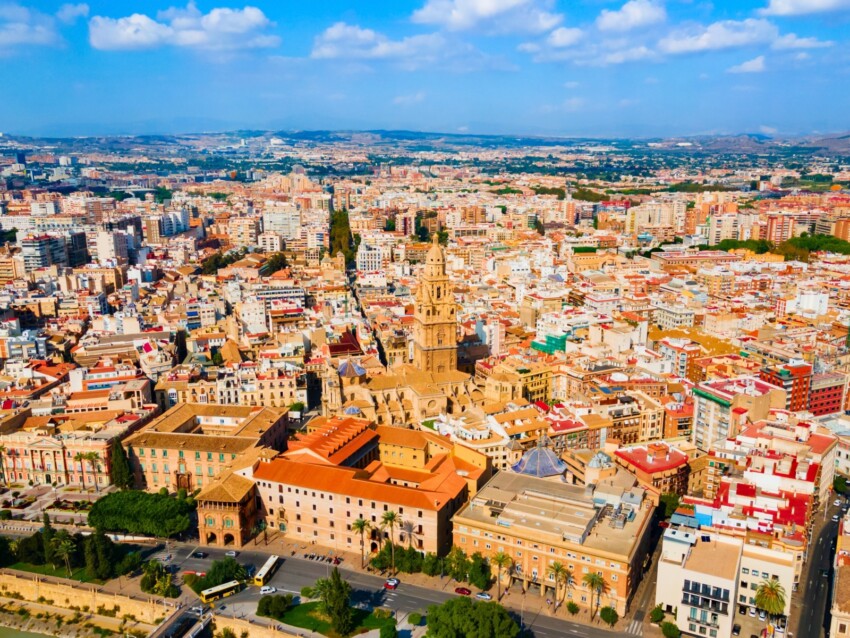

Squeezed between Andalusia and the Valencia region, Murcia is a world of its own. The capital of the region of the same name in south-eastern Spain lies on a fertile plain crossed by the Segura river and surrounded by mountains: seemingly isolated, it is actually only 40 km from the coast.
It is a rather large city, with a population of over 400,000 inhabitants, famous above all for its university, which is chosen by many students as the location for their Erasmus trips.
Erasmus students aside, very few tourists have ventured to Murcia and perhaps this is one of the reasons why this city of Arab origin still seems so authentic.
For an original holiday, away from the hustle and bustle of tourist cities, it is the ideal destination: stay a few days or a whole week, visiting the scenic and cultural wonders of the surroundings.
Murcia is a city that surprises visitors with its cultural and architectural richness. From the majestic cathedral complex to the lively historic squares, every corner tells a story of art, faith and tradition. The city offers a perfect balance of historical monuments and modern cultural attractions.
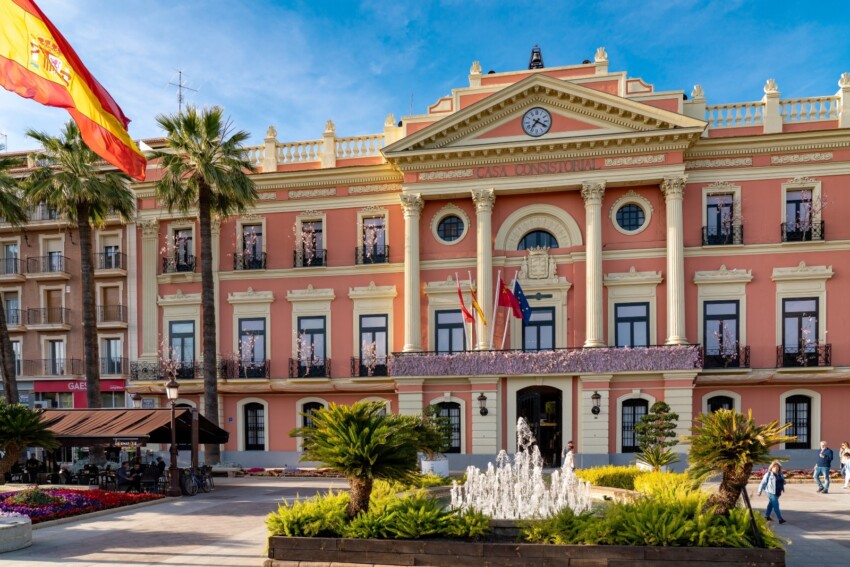
The heart of the city centre is Plaza de La Glorieta, an elegant tree-lined pedestrian square where the city hall and bishop’s palace are located.
A few steps from here you can admire the Puente Viejo, the oldest bridge in the city, built entirely of stone; it is also known as Puente de Los Peligros because the statue of Our Lady of Perils is located on the south side of the bridge.
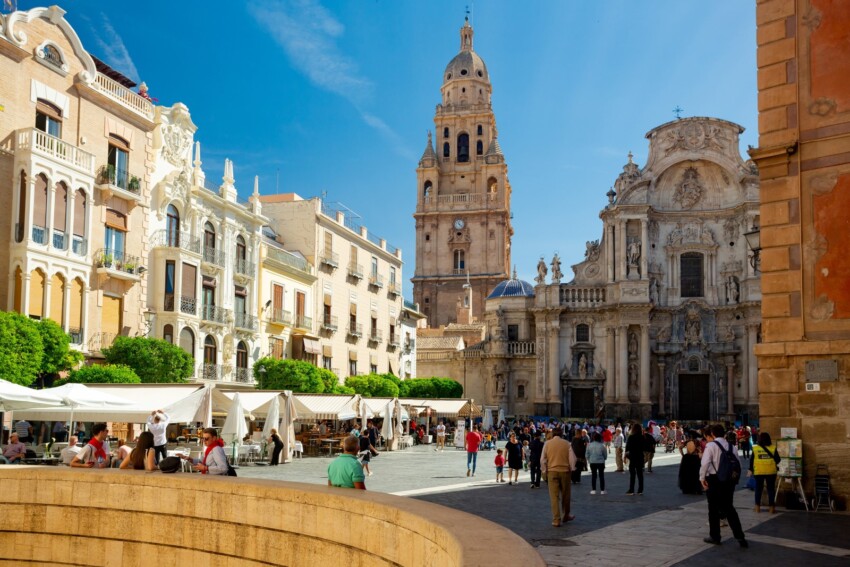
The Cathedral of Santa María is undoubtedly the most representative symbol of Murcia. Built between 1394 and 1465, this imposing structure represents a fascinating mix of architectural styles, from the original Gothic to later Baroque additions. Its 93-metre high bell tower is considered the second most important in Spain after the Giralda in Seville.
The most striking element is the Baroque façade, completed in 1751, which is considered a masterpiece of Spanish Baroque. Its elaborate decorative programme includes statues, reliefs and ornaments that tell biblical stories and celebrate the history of the diocese.
Inside, the cathedral houses the Chapel of the Vélez, a jewel of flamboyant Gothic architecture, and the Cathedral Museum, which houses precious liturgical objects and sacred artwork. A visit to the bell tower offers a breathtaking panoramic view of the city and the surrounding fertile plain.
The Plaza del Cardenal Belluga is the monumental heart of Murcia. This elegant square is surrounded by some of the city’s most significant buildings, creating an architectural ensemble of extraordinary beauty.
In addition to the Baroque façade of the Cathedral, the square is overlooked by the Episcopal Palace, a magnificent example of 18th century Rococo architecture, with its characteristic pink façade. The third distinctive element is the modern Moneo Building, designed by architect Rafael Moneo, which creates an interesting contrast with the surrounding historical buildings.
The square is a popular meeting place for tourists and residents alike, with numerous cafés and restaurants allowing visitors to enjoy the unique atmosphere of the place.
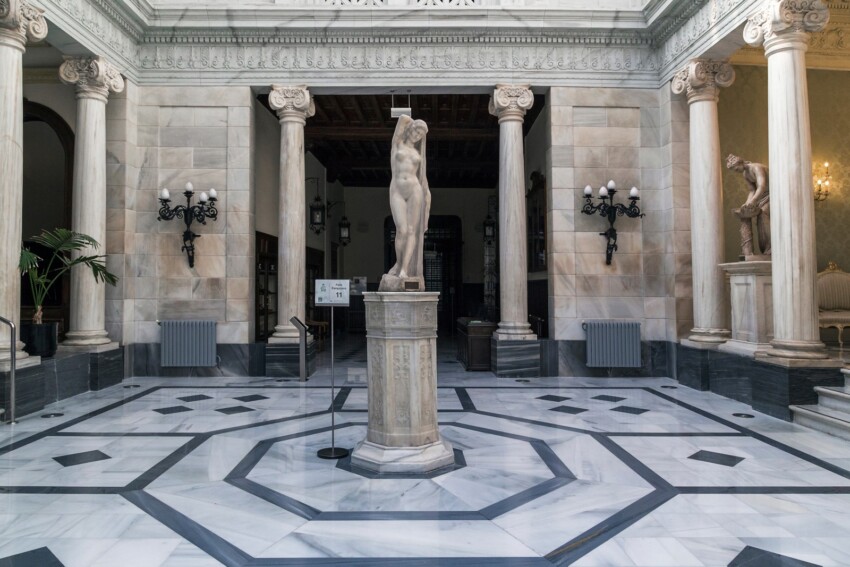
The Casino Real is one of the city’s most fascinating buildings, an outstanding example of eclectic 19th century architecture. Built as a social club for the local elite, today it is a national monument open to the public.
The interior of the Casino is a riot of luxury and sophistication, with a series of richly decorated themed rooms. The Patio Árabe is particularly impressive, with its elaborate stuccoes and mosaics inspired by the Alhambra in Granada. The Historical Library, with its carved wooden shelves and collection of old books, is another highlight of the visit.
The Salzillo Museum is dedicated to the work of Murcia’s most famous sculptor, Francisco Salzillo (1707-1783). The museum houses an extraordinary collection of Baroque religious statues, including the famous nativity scene composed of over 500 miniature figures.
The most impressive works are the Holy Week processional pasos, huge sculptural groups depicting scenes from the Passion of Christ. These masterpieces show not only Salzillo’s exceptional artistic talent, but also the importance of religious traditions in Murcian culture.
The Mercato de Verónicas is Murcia’s main covered market, a modernist building from 1916 that houses one of the city’s liveliest food markets. Located along the Segura River, the market is the ideal place to discover the wealth of Murcian gastronomy.
Inside, over 100 stalls offer an impressive variety of fresh local produce, from the region’s famous peppers and tomatoes to fresh fish from the coast, from traditional cured meats to artisanal cheeses. It is a unique sensory experience and an excellent opportunity to immerse oneself in the local culture.
The Santuario de la Fuensanta, located at the top of Monte del Carrascoy, is the region’s main pilgrimage site and offers spectacular views of the city and valley. The current sanctuary, built in the 18th century, houses the image of the Virgin of Fuensanta, patron saint of Murcia.
The complex also includes a small museum displaying votive offerings and religious objects, while the surrounding gardens are a perfect place for a peaceful walk with panoramic views.
The Jardín de Floridablanca is the oldest public garden in Spain, created in 1785. This historic park offers an oasis of tranquillity in the centre of the city, with centuries-old trees, historic fountains and memorials.
The garden is particularly known for its huge, centuries-old ficus trees and the statue dedicated to the Count of Floridablanca. It is a popular place for relaxation and recreation, frequented by tourists and residents alike.
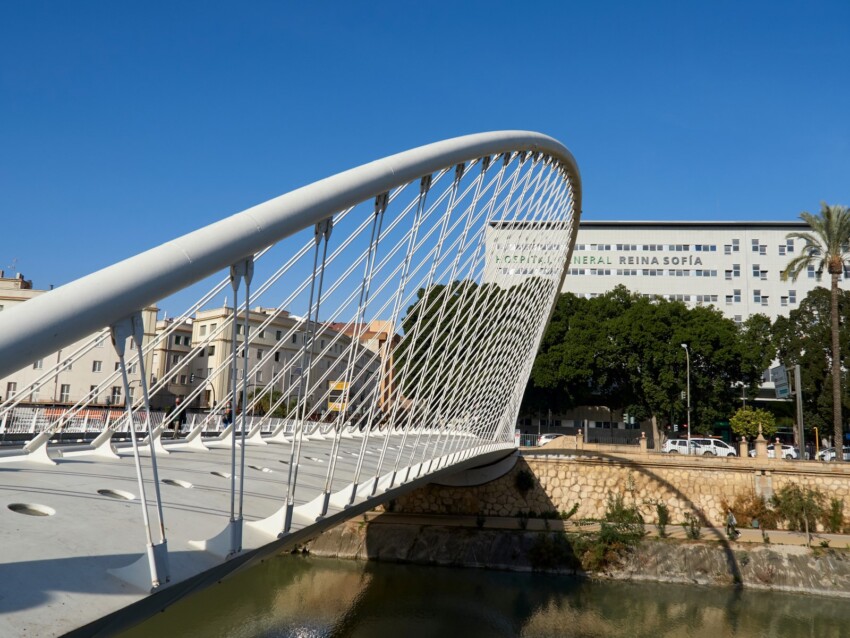
There are seven bridges connecting the two banks of the river, some old, others very recent. Crossing the Vistabella pedestrian footbridge linking the neighbourhood of the same name with the Infante barrio, you might get the impression that you have already seen this bridge somewhere else.
It was designed by Santiago Calatrava, the Spanish archistar, but the metal tube and glass floor structure, so dear to the internationally renowned architect, has not been particularly popular with residents due to the numerous maintenance operations that have been necessary.
In the following map you can see the location of the main places of interest mentioned in this article.
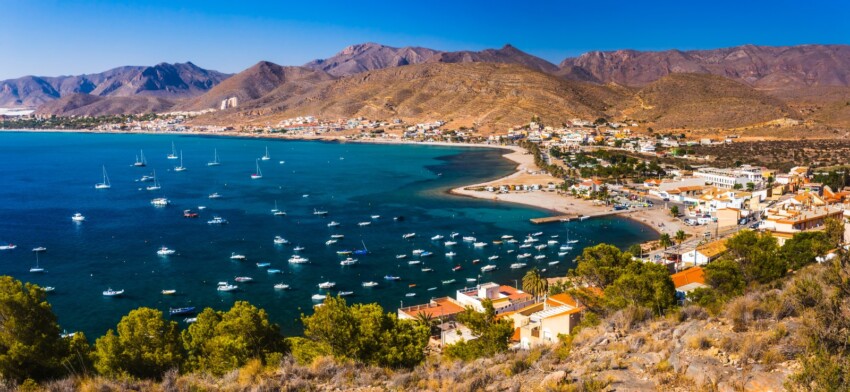
You only have to put your nose outside Murcia to find yourself surrounded by fascinating natural landscapes. Take advantage of this for exciting day trips or outdoor activities.
The sea is only 40 km away and you can enjoy the beautiful beaches of the Costa Cálida, still untouched by mass tourism, with opportunities for diving and other water sports. The surrounding mountains, on the other hand, offer numerous opportunities for hiking and mountain biking.
With a rental car, you can create your own itinerary to discover the most charming villages or prestigious wine cellars in the region.
Cartagena, an ancient port city founded by the Carthaginians, is located just 50 km from Murcia. The city boasts an impressive historical heritage that includes a perfectly preserved Roman theatre, military fortifications and modernist palaces. Its natural harbour, one of the most important in the Mediterranean, offers a pleasant seaside promenade with numerous fish restaurants.
The Mar Menor is the largest saltwater lagoon in Europe, located about 45 km from Murcia. This unique stretch of water offers quiet beaches, water sports and natural spas. Coastal towns such as Los Alcázares and Santiago de la Ribera are perfect for a relaxing day by the sea.
The Sierra Espuña Regional Park, 40 km from Murcia, is a paradise for nature lovers and hikers. This mountain massif offers numerous hiking trails, picnic areas and viewpoints. The visitor centre provides detailed information on the routes and the local flora and fauna.
Caravaca de la Cruz, one of the five holy cities of Catholicism, is located 85 km from Murcia. The town is famous for its castle-sanctuary that houses the Vera Cruz. Its medieval old town and numerous religious events make it an attractive destination for cultural tourism.
The good news for those who want to sleep in Murcia is that hotel and b&b prices are very good compared to the Spanish average. The bad news is that, as a strong tourist industry has not developed in the area, there is less choice than in other locations.
The historic centre of Murcia is the ideal area for tourists who want to be comfortable. This area offers easy access to all the main monuments, restaurants and shops. Hotels in this area are often housed in renovated historical buildings, combining period charm with modern comforts. The area around the Cathedral and Plaza de las Flores is particularly attractive and convenient for exploring the city on foot.
Murcia is very attached to its traditions and here, as in other regions of southern Spain, popular festivities reach their peak of participation and excitement during Holy Week.
If you are here during Easter, don’t miss the Salzillo procession, the most spectacular of all processions in Murcia, which starts on the morning of Good Friday.
The first Tuesday after Easter is the Bando de la Huerta, a lively traditional festival with parades, tastings of typical products and readings of verses in a local dialect called ‘panocho’.
A bizarre spring festival is the Funeral of the Sardine, a parade that concludes the carnival. The sardine is carried in procession to the place where it will be burnt during a fireworks display that kicks off a big party until morning.
Murcia enjoys a strategic location in south-eastern Spain, easily reached by plane, train or car. The city is served by two main airports, offering several options for international travellers.
The Murcia Region International Airport (RMU) is located 23 km from the city centre. It is connected to the centre by a regular bus service that takes about 45 minutes. The cost of the ticket is approximately 5 euro. Alternatively, taxis take 25 minutes and cost around 35-40 euros.
Alicante-Elche Airport (ALC), located 70 km from Murcia, offers a wider range of international connections. It is connected to Murcia by a shuttle bus service that takes about 55 minutes (cost EUR 10). Taxis from this airport cost around 85-90 euros.
For those arriving by train, the Murcia del Carmen station is well connected to the main Spanish cities. High-speed trains (AVE) connect Madrid to Murcia in about 3 hours and 45 minutes, while from Valencia the journey takes about 3 hours.
Those travelling by car can easily reach Murcia via the A-7 motorway (from Valencia or Almería) or the A-30 (from Madrid). The city has several underground car parks in the historic centre.
What's the weather at Murcia? Below are the temperatures and the weather forecast at Murcia for the next few days.